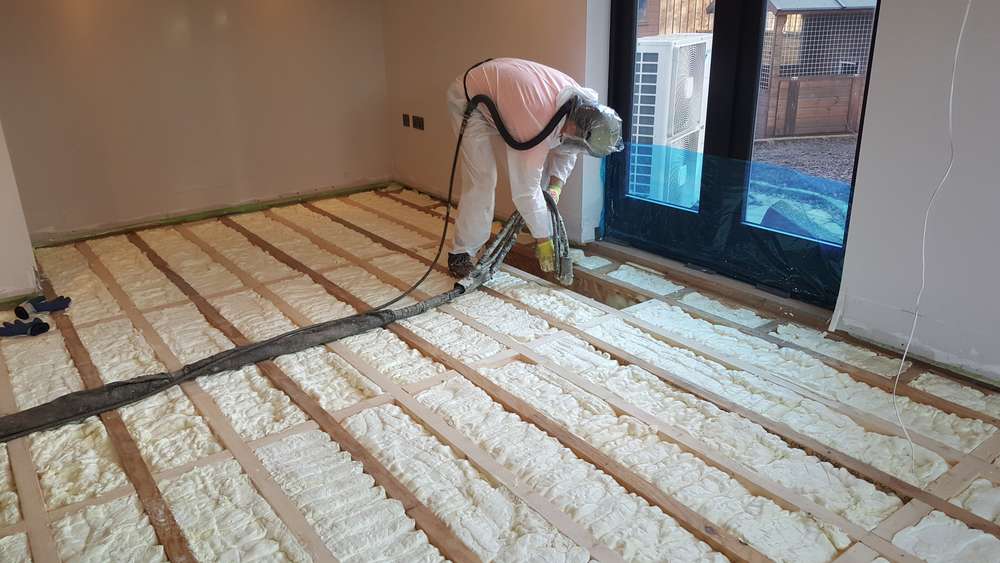Attic Spray Foam Insulation Athboy
3 Bed Semi Attic Insulation Athboy

Attic Insulation Athboy
Spray foam can be useful in many conditions. Spray foam is useful in roofs, windows, attics, underfloor heating systems, interior and exterior walls, as well as roofs.
Spray foam insulation will keep your home warm during winter and cool in summer. Spray foam insulation allows the house to breathe because it allows moisture-laden atmosphere to escape through its “Cell” structure.
Benefits of Spray Foam Insulation for your home
Other uses include: commercial and industrial buildings; agricultural farms houses; sheds; shipping containers; vessels; and the refrigeration industry.
It also forms an airtight seal around your home to prevent rain and cold wind from entering. This is a major disadvantage over other insulation products currently on the market, as it allows heat to escape from your home.


Cost Price Of Spray Foam Insulation
Spray foam insulation is without doubt the most efficient insulating material today. It is more efficient than traditional insulating materials like fiberglass, rock wool and cellulose.
Spray foam insulation can also be used as a sound barrier. It reduces outside noise by up to 50%. It is a great advantage if a company or home is in a densely populated area or close to an airport.
Insulate Your Athboy Property Properly
It’s used to dampen sounds that travel from room to room and across floors between interior walls. It is particularly useful in bathrooms, where the noises of flushing toilets and showers can be annoying.
It is easy to use and does not cause any disruptions to your daily activities.
Traditional Irish homes can be insulate in just one day.
It reduces the noise of in-wall and under-floor pipes by encasing them and isolating them.

Boards should be laid over the joists if the loft or attic is to be used for storage. It is not enough to insulate between the joints if you do not cover the entire area.
It is much more effective than fibreglass, rock wool or polystyrene panels when used inside walls, roofs, floors and attics. Its dense composition, and its application process results in an envelope that is completely airtight. It blocks sound from outside, including traffic, pedestrianised streets, and areas near airports.
It also blocks sounds from a structure’s walls from reaching other floors, including the floors below. Spray foam insulation could reduce the amount of noises generated by structures such as running showers or washing machines.
Spray foam insulation that is both flexible, and filled with millions and millions of air bubbles will absorb the vibrations of the floor. The floor’s wooden members and floor will also be affected. Spray foam insulation reduces sound transmission by sealing any cracks or crevices that airborne noises can travel through.
Spray foam insulation reduces, if any, the sound of water passing through pipes. The insulation completely surrounds pipes to prevent them from moving and keeps them secure. It also prevents hot water from flowing through the pipes, which can cause the wooded beams to creak, crackle and expand.
It also keeps heat from escaping to upper floors, which causes lower floors to become colder, which in turn makes them require more heat to keep warm. The upper floors become too hot.
If your loft is easily accessible and does not have condensation problems, insulation should be straightforward.
An uninsulated home loses 25% of its heat through its roof. Insulating your loft or attic is a great way to cut heat loss and save money on heating.
Rolls of mineral wool insulation can be used if access is good and the loft joists have regular dimensions. The insulation is first laid between the horizontal beams, or joists, that make up the loft floor. Next, another layer is laid at right angles so the insulation can be covered to the desired depth.
You can raise the floor to get sufficient insulation. Timber battens can be fitted across the joists. Alternatively, you can purchase purpose-built plastic legs to fit onto the joists and support your new floor. To prevent condensation from forming on the boards’ undersides, it is important to ventilate the air gap between insulation and boards.
Do not squash the mineral Wool when fitting the boards onto the top. This will cause it to lose its insulation properties.
Insulation stops heat from escaping to living spaces. If your loft is not cool enough, it could make existing damp or condensation worse. Consider increasing ventilation if you’re installing loft insulation by yourself.
Another way to insulate your loft would be to place insulation between and above the rafters. These are sloping timbers which make up the roof. You have the option of using rigid insulation boards carefully cut to size or foam insulation sprayed between your rafters.
Some companies offer to fix a roof that is leaking or damaged by applying foam insulation directly to the roof. This will not solve the problem. This is not something that we recommend. You must ensure that your roof is in good condition before you apply insulation.
You can use your loft to heat the space, but you will need to create a separate room on the roof.
If you are planning to use your loft for living, or you already have it, you will need insulation between the heated space and unheated area.
For your home to remain fresh, dry, healthy and clean, it needs air flow. A professional installer will ensure that your house does not have any obstructions or seals. Do not cover any grilles, vents, or airbricks if you do DIY insulation.
A professional can install blown insulation in a loft that is difficult to reach. They will use special equipment to blow the appropriate insulation material into any space. They might use treated cellulose, mineral wool fibre or polyurethane foam.
Flat roof insulation can save you as much on heating costs than loft insulation. The amount of flat roofing on a property will determine how much savings you get.
If the loft is accessible, has no damp problems, and is not on a flat roof you can likely insulate it yourself. For those cases when damp is a problem or a more complex insulation system, professional installation should be done.
Your loft hatch could become colder due to the cooler air. This can be prevented by installing an insulated hatch in your loft and putting strips of draught-exclusion material around the hatch edges.
Insulating your groundfloor is a great way for your property to stay warm as well as lowering your energy bills.
Insulating your loft is a great way to cut down on heating costs and save energy. It also keeps the home warm in winter. Even if you already have insulation, it is crucial to have the best amount in order to make it effective.
Loft floor rolls – These are the more traditional option. They are rolled along the loft’s floors. They are quicker to lay than insulated flooring boards. They can be purchased as either loose (blanket), or encapsulated (blanket), and can be used to make both top and base layers. You can use stilts or boards to board them. This will create a raised platform that is suitable for storage.
These tips and recommendations aren’t listed in this article’s tool and material list. Make sure you read the entire article to ensure you are fully equipped to insulate your loft floor safely.
There may be some insulation in your home, but it may not work well. This could happen if the insulation isn’t topped up regularly or has been compressed by storage board. Older properties may have a loft floor as low as 25mm deep.
It’s not necessary to remove loft floor insulation. To reach the recommended level, simply add one or more layers to it. You will find more information about the recommended amount in the article.
Your loft floor’s spacings will dictate the width of your roll. This is because the insulation rolls between these joists. It is best to choose one that matches your joist spacing. This reduces the need for trimming.
The insulation must have the required thermal resistance. Alternativly, you can measure the insulation’s thickness if you are only laying loft rolls. Refer to the section titled “How to calculate the loft floor insulation thickness required” for more details.
Areas We Service


Parkhill, Dublin
01 5255297

